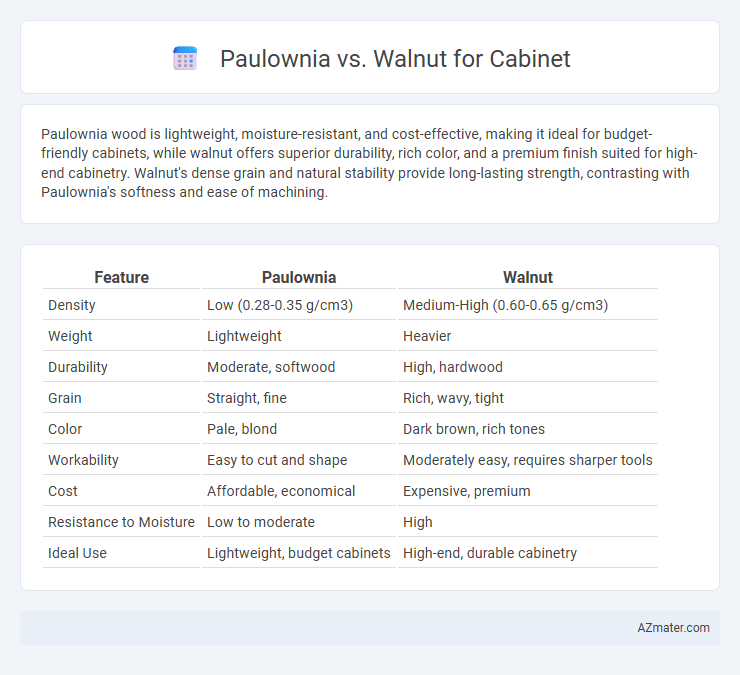Paulownia wood is lightweight, moisture-resistant, and cost-effective, making it ideal for budget-friendly cabinets, while walnut offers superior durability, rich color, and a premium finish suited for high-end cabinetry. Walnut's dense grain and natural stability provide long-lasting strength, contrasting with Paulownia's softness and ease of machining.
Table of Comparison
| Feature | Paulownia | Walnut |
|---|---|---|
| Density | Low (0.28-0.35 g/cm3) | Medium-High (0.60-0.65 g/cm3) |
| Weight | Lightweight | Heavier |
| Durability | Moderate, softwood | High, hardwood |
| Grain | Straight, fine | Rich, wavy, tight |
| Color | Pale, blond | Dark brown, rich tones |
| Workability | Easy to cut and shape | Moderately easy, requires sharper tools |
| Cost | Affordable, economical | Expensive, premium |
| Resistance to Moisture | Low to moderate | High |
| Ideal Use | Lightweight, budget cabinets | High-end, durable cabinetry |
Introduction to Paulownia and Walnut
Paulownia wood is lightweight, highly resistant to warping, and known for its fast growth rate, making it an eco-friendly choice for cabinets. Walnut wood offers rich color, exceptional durability, and a smooth grain pattern, often favored for high-end woodworking and cabinetry. Both woods present distinct advantages: Paulownia excels in weight and sustainability, while Walnut provides strength and elegant aesthetics.
Wood Grain and Appearance Comparison
Paulownia wood features a light, uniform grain with a smooth texture and pale yellow to cream color, offering a contemporary and airy aesthetic for cabinets. Walnut presents a rich, dark brown hue with intricate, swirling grain patterns and occasional knots, providing a classic, luxurious appearance. The stark contrast between Paulownia's subtle, minimal grain and Walnut's bold, dramatic grain makes walnut a preferred choice for statement cabinetry, while Paulownia suits modern, minimalist designs.
Strength and Durability of Each Wood
Paulownia wood, known for its lightweight and moderate strength, offers good resistance to warping but generally lacks the density found in walnut, impacting its overall durability in high-use cabinetry. Walnut wood provides superior strength and durability due to its dense, hardwood nature, making it highly resistant to dents, scratches, and wear, ideal for long-lasting cabinets. While Paulownia excels in ease of handling and moisture resistance, walnut's robustness and longevity make it a preferred choice for heavy-duty cabinetry applications requiring enduring structural integrity.
Weight: Lightweight vs. Heaviness
Paulownia wood is known for its exceptional lightweight properties, making it ideal for cabinets that require easy handling and reduced strain during installation. In contrast, walnut is significantly heavier, offering increased durability and a solid, sturdy feel that enhances cabinet longevity. Choosing between paulownia and walnut depends on whether lightweight convenience or robust heaviness is the priority for cabinet construction.
Workability and Ease of Machining
Paulownia wood is highly favored for cabinetry due to its exceptional workability and ease of machining, offering a lightweight yet stable material that reduces wear on tools and speeds up production. Walnut, while denser and heavier, provides a smooth finish and holds intricate details well but requires sharper tools and more effort during cutting and shaping. Both woods deliver quality results, yet paulownia is preferred for projects prioritizing quick handling and efficient fabrication.
Finishing Qualities and Staining Results
Paulownia wood exhibits excellent finishing qualities with a smooth, even grain that readily absorbs stains, resulting in vibrant and consistent color tones ideal for cabinet applications. Walnut, known for its rich, dark hues and natural luster, finishes exceptionally well with oils and stains, enhancing its deep grain patterns and providing a luxurious, elegant appearance. While Paulownia offers lighter, more uniform staining results, walnut delivers a more dramatic and sophisticated finish with greater depth and contrast.
Cost and Availability in the Market
Paulownia wood is significantly more affordable than walnut, making it a budget-friendly choice for cabinetry, while walnut's higher cost reflects its premium status and durability. Paulownia is lightweight and fast-growing, resulting in more consistent availability and quicker replenishment in the market compared to the slower-growing walnut. Walnut's scarcity and demand in luxury furniture markets contribute to limited availability and higher prices, whereas paulownia's abundance supports steady supply for mass production.
Environmental Impact and Sustainability
Paulownia wood is highly sustainable due to its rapid growth rate and ability to absorb large amounts of CO2, making it an eco-friendly choice for cabinets. In contrast, walnut grows much slower and often requires harvesting old-growth forests, leading to a higher environmental impact and less sustainable practice. Choosing Paulownia for cabinetry reduces deforestation pressure and promotes renewable wood sourcing in sustainable furniture production.
Best Uses for Cabinets: Paulownia vs Walnut
Paulownia wood is lightweight, highly resistant to warping, and ideal for cabinet frames and interior panels where weight reduction and stability are crucial. Walnut, known for its rich color, durability, and fine grain, is preferred for visible cabinet parts such as doors and drawer fronts that require an elegant finish and long-lasting wear resistance. Choosing between Paulownia and Walnut depends on the cabinet's functional requirements, balancing lightweight construction with aesthetic appeal and hardness.
Final Verdict: Which Wood is Better for Cabinets?
Paulownia offers lightweight properties and resistance to warping, making it ideal for easy-to-handle cabinet construction, while walnut provides superior durability, rich color, and natural grain patterns that enhance cabinetry aesthetics. Walnut's hardness score of 1010 on the Janka scale ensures long-lasting wear and superior resistance to dents, contrasting with Paulownia's softer texture and lower density. For high-end, durable cabinetry with a luxurious appearance, walnut is the preferred choice, but Paulownia suits budget-friendly projects where weight savings and ease of machining are priorities.

Infographic: Paulownia vs Walnut for Cabinet
 azmater.com
azmater.com